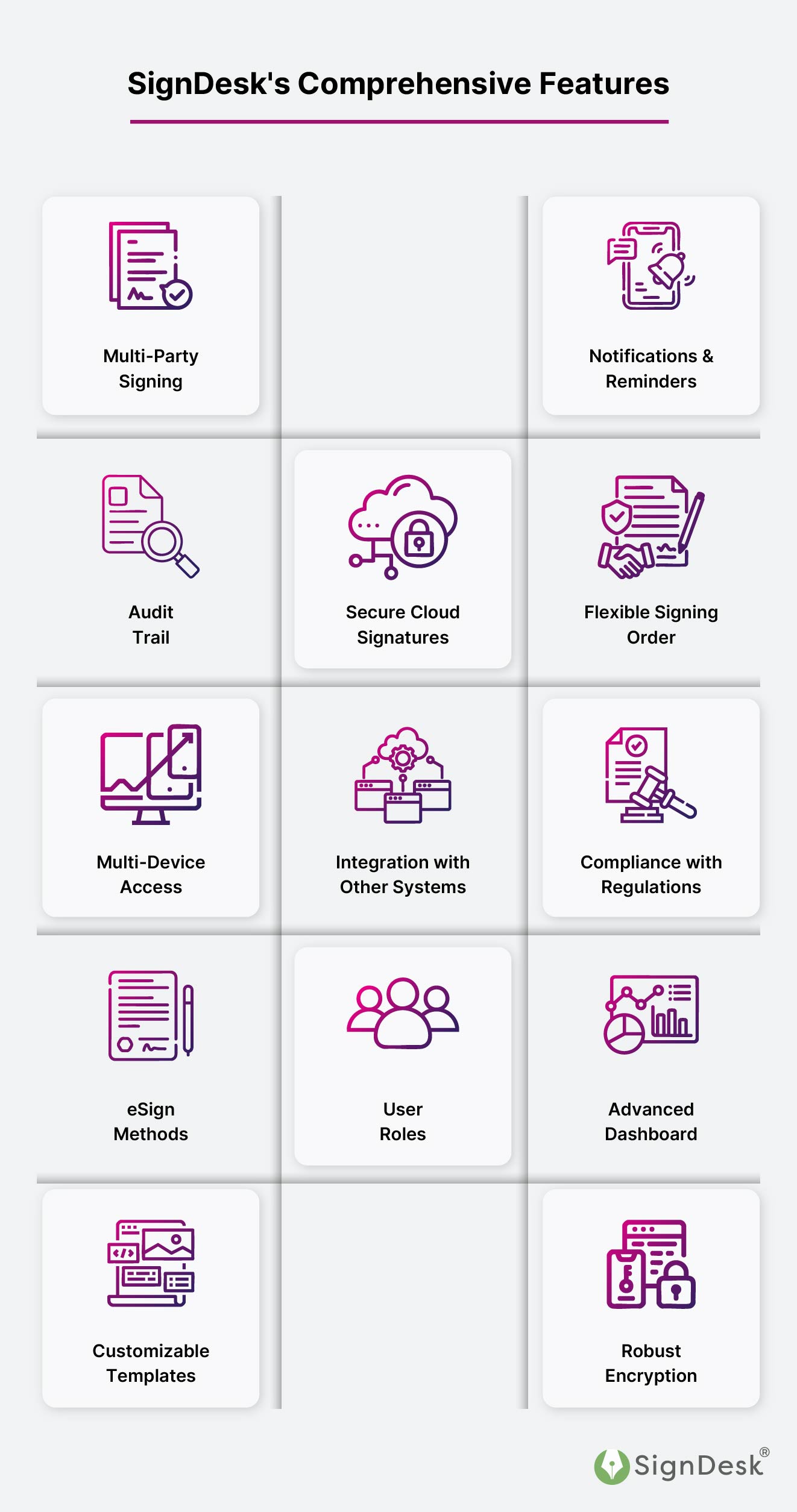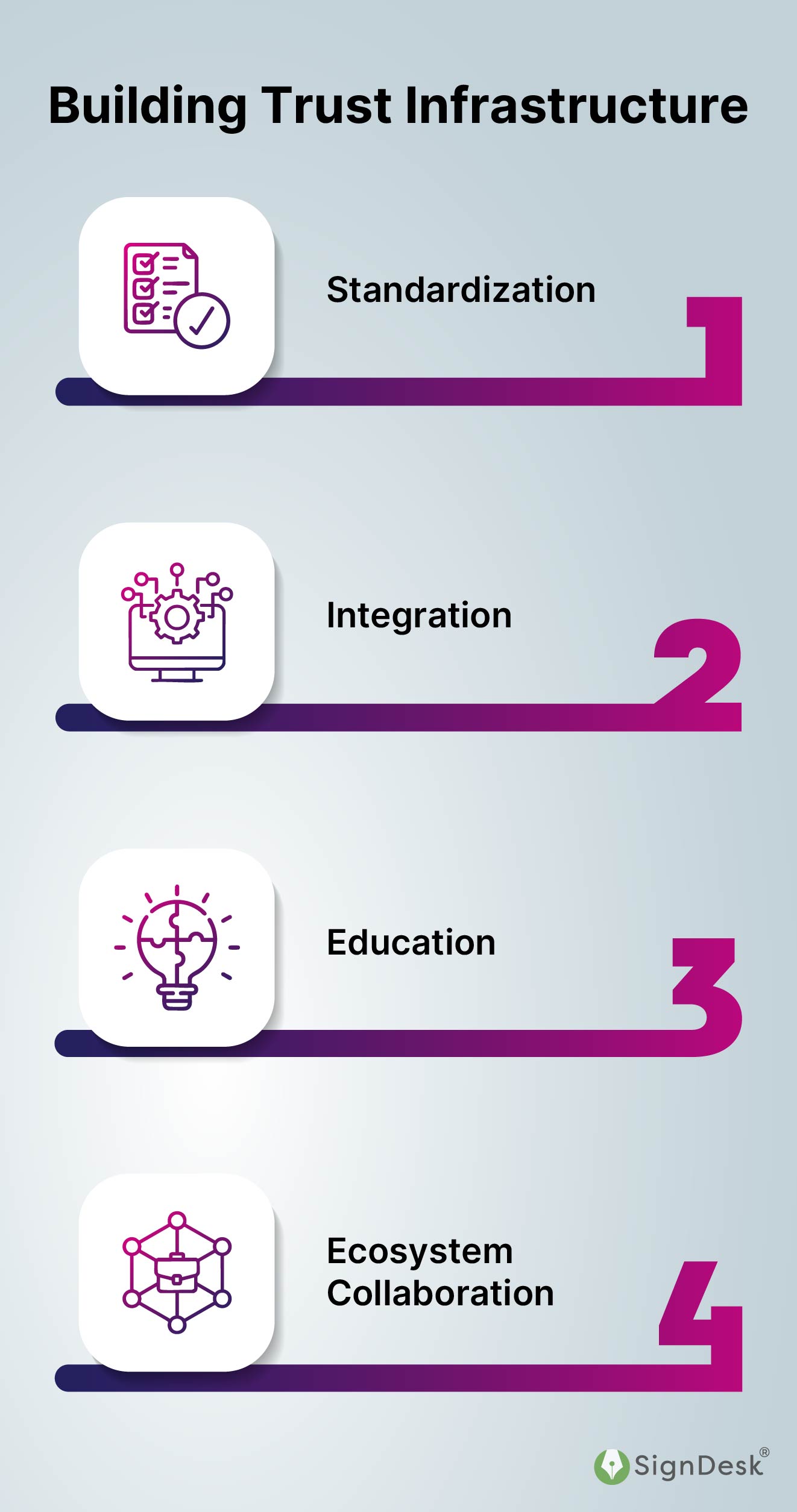In a digital-first economy, trust is the foundation for credible transactions and sustainable growth. As organizations scale across geographies, engage distributed workforces, and automate core processes, the need for secure, seamless identity verification is growing rapidly.
One technology that sits at the intersection of legality, security, and usability is the electronic signature.
Electronic signatures, traditionally considered as utilitarian replacements for ink-based signatures, are now evolving into sophisticated trust protocols. These emerging systems possess the potential to reshape organizational approaches to verify identities and establish authenticity across the entire digital business lifecycle. By providing digital identities that are verified and legally enforceable, eSign can do more than facilitate transactions, they can establish persistent trust across geographies and ecosystems.
SignDesk is at the forefront of this shift, offering integrated platforms that combine identity verification, regulatory compliance, and advanced security protocols. These capabilities position eSignatures to become the primary layer for secure, scalable digital interactions.
Between 2020 and 2024, eSignature platforms have experienced significant capability growth across six key areas—from identity verification to AI integration. As shown below, AI integration has surged by 600%, blockchain implementation has tripled, and audit trail generation has more than doubled. These advancements indicate that eSignatures are quickly becoming integral to establishing identity, verifying intent, and maintaining document integrity at enterprise scale.

The Architecture of Digital Trust: Identity, Intent, and Integrity
At the core of any contractual agreement lie three fundamental pillars:
- Who is signing (identity)
- Why are they signing (intent)
- What they are signing (integrity)
Modern platforms go well beyond simple digital signoffs. They integrate multi-factor authentication, Know Your Customer (KYC) compliance, behavioral analytics, and cryptographic audit trails. These features enable enterprises to embed trust into every stage of the contract lifecycle, from initiation to renewal.
In sectors such as manufacturing and financial services, inefficient or manual contracting workflows have been shown to reduce deal velocity and slow innovation by as much as 40%. eSignatures, when embedded within enterprise platforms, can shift the contracting model from static PDFs to “living documents” that update in real time and carry a continuous chain of custody. Organizations using SignDesk’s AI-driven contract workflows have significantly accelerated their time-to-agreement while reducing compliance gaps.
From Signature to System: Embedding Trust in Business Architecture
Contracts represent the definitive record of value exchange, yet evidence suggests that many organizations continue to use fragmented, manual contracting processes, leading to significant operational friction.
Industry analysis across technology and manufacturing sectors indicates that inefficient contracting slows down deal velocity and innovation by up to 40% – a risk profile that extends far beyond the legal departments.
Contemporary eSignature platforms like SignDesk have evolved beyond simple signature capture functionality to incorporate more advanced verification systems. They now include:

The living contract paradigm
By strategically embedding eSignature capabilities within Contract Lifecycle Management (CLM), organizations can transition toward living contracts: dynamic documents that are continuously updated, monitored, and integrated into enterprise systems. This allows an eSignature to function as a persistent authentication token, linked to verified identity and providing auditability throughout every amendment, renewal, or obligated modification cycle.
The resulting unified trust infrastructure enables integration of:
– Identify verification protocols
– Document management systems
– Transaction approval workflows
– Compliance monitoring frameworks
By replacing siloed systems with a unified architecture, the organizations can reframe every digital interaction as a verifiable, auditable component within a continuously governed trust framework. This consolidation can reduce complexity by up to 60%, enhancing enterprise-wide data coherence, strengthening the organization’s security, while also enabling scalable automation and advanced analytics to drive operational agility and informed strategic decision-making.
Toward a Standardized, Interoperable Trust Layer
Despite legal recognition in most jurisdictions, the global landscape for eSignatures remains fragmented. Regional frameworks like the EU’s eIDAS, the U.S. ESIGN Act, and India’s Aadhaar provide localized assurance, but interoperability is limited.
Given the current fragmentation, utilizing the private sector, particularly those that have already embedded eSignatures in business processes, may offer the fastest path to global alignment and standardization. With widespread adoption across private industries and jurisdictions, eSignatures are uniquely positioned to act as trust anchors.
When integrated with a verified credential system encompassing government IDs, digital wallets, or decentralized identity systems, eSignatures could evolve into portable, secure, and auditable trust tokens. This evolution mirrors pivotal/historical milestones in digital infrastructure, wherein the Society for Worldwide Interbank Financial Telecommunication (SWIFT) standardized global banking operations, and Hypertext Transfer Protocol Secure (HTTPS) established web security protocols. Similarly, a unified eSignature protocol has the potential to define the future of global business identity and agreement.
SignDesk’s cross-industry platform, which already connects identity verification and contract workflows across geographies, is well-positioned to contribute to a globally accepted trust framework. As organizations look to combine eSignatures with digital wallets, decentralized identity systems, and government IDs, platforms like SignDesk offer the essential bridge, providing auditable, portable, and secure trust tokens that can scale internationally.
Enabling Risk Management and Compliance at Scale
Regulatory compliance represents both a challenge and an opportunity in the evolution toward eSignature-based digital identity. eSignatures are legally recognized in most countries, under frameworks like the U.S. ESIGN Act, the EU’s eIDAS regulation, and the UN’s Model Law on Electronic Signatures. Depending on jurisdiction and assurance level (basic, advanced, or qualified), eSignatures carry different legal weights. But as global compliance requirements expand, centralized platforms with immutable audit trails, automated workflows, and real-time identity verification provide a strong defense against legal, operational, and reputational risks.</p.
The strategic advantages extend beyond legal compliance to encompass comprehensive risk management capabilities. Centralized eSignature systems provide:
- Enhanced fraud and impersonation risk mitigation through robust identity verification
- Immutable audit trail generation for dispute resolution processes
- Automated compliance workflow enforcement
- Enhanced visibility for internal governance and external regulatory oversight requirements
Strategic Implementation: Four Building Blocks
The transformation of eSignatures from a utilitarian tool to a foundational trust protocol requires an enterprise-wide shift at both the organizational and technological levels.

- Standardization
- Development of industry-wide protocols for identity verification methodologies
- Establishment of cryptographic implementation standards
- Creation of comprehensive audit logging frameworks
- Implementation of interoperable digital trust mechanisms
- Integration
- Embedded within Contract Lifecycle Management systems
- Integration with Enterprise Resource Planning platforms
- Connection to Customer Relationship Management architectures
- Alignment with identity management system protocols
- Executive Education
- Strategic enablement for organizational agility enhancement
- Security framework strengthening initiatives
- Customer trust establishment mechanisms
- Ecosystem collaboration
- Governmental authority engagement protocols
- Regulatory body coordination frameworks
- Technology vendor partnership development
- Enterprise organization alliance building
Artificial Intelligence Integration and Smart Contract Evolution
Generative artificial intelligence technologies are fundamentally transforming contract creation, review, and analytical processes. Advanced AI capabilities now enable automated clause generation, comprehensive risk identification, and strategic negotiation recommendation systems, thereby revolutionizing contract lifecycle management operational frameworks.
However, AI-generated agreement systems introduce complex questions regarding authorship attribution, accountability assignment, and legal enforceability standards that organizations must address through strategic implementation approaches.
When AI systems draft contractual terms or autonomous execution occurs through smart contract systems, establishing human oversight and accountability mechanisms is essential. Here, eSignatures reassert strategic value, not merely as process endpoints, but as verification mechanisms for human accountability.
When eSignatures are embedded within smart contract systems, they create audit points within autonomous workflows, ensuring that machine-driven processes remain traceable to human accountability. By embedding SignDesk’s eSignatures within AI-driven processes, businesses can ensure that even machine-executed agreements maintain traceability, integrity, and human oversight.
Looking ahead: Trust as Strategic Infrastructure
As generative AI and autonomous systems reshape the contract landscape, questions of authorship, accountability, and enforceability will become more complex. In this context, eSignatures re-emerge as critical points of human oversight within automated workflows.
Although no standalone solution can resolve the complexities of digital trust, eSignatures, when elevated beyond the act of signing, offer a foundational protocol for identity verification, intent confirmation, and integrity assurance at scale.
Organizations that elevate eSignatures from functional utilities to core trust infrastructure position themselves to capitalize on emerging opportunities in a digitally connected global economy.
The shift towards a trust-centric infrastructure is already underway, grounded in technologies already embedded within global business operations. For leadership teams, the question is no longer whether to deploy eSignatures—but how to embed them as core trust infrastructure that accelerates growth, ensures regulatory compliance, and future-proofs digital operations.
Discover How SignDesk Powers Trust-First Digital Workflows
Connect with our team to learn how SignDesk can help you build trust-driven contract experiences at scale.